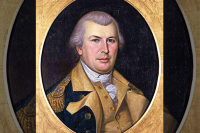The honest little bird

On one level, the natural history of a region consists of its terrain, habitats, plants, animals and how they interrelate. I also believe that no full understanding of the natural history of a region can be realized without coming to terms with its spiritual landscape. And when we consider the spiritual landscape of the Smokies region, we enter the realm of the ancient Cherokees.
They called themselves the Ani-Yun-wiya, which signified they were The Principal People. As such, the Cherokees assumed that it was their responsibility to maintain harmony and balance — not only in their homeland but also in the universe. They did so by invoking the powers of the Upper World to help them neutralize the powers of the Under World, in order to bring balance and peace into the mundane Middle World occupied by humans and the four-legged animals.
Quite naturally, birds epitomized the Upper World — the realm of light and everlasting life. The Cherokees were keen observers of bird life here in the Blue Ridge. They were the region’s first ornithologists. As we do today, they admired birds for their beauty, for their ability to sing, and — most of all — for their ability to fly. Many of their legends are concerned with birds, and their sacred formulas (poems, songs, and chants) constantly evoked them for various purposes.
Two of the more common birds the Cherokees observed year-round were the Carolina chickadee and the tufted titmouse. They named the chickadee Tsikilili, a word that imitates the bird’s call. The titmouse they named Utsugi, which means “topknot” in reference to its crested head.
The chickadees and the titmice are closely related, are about the same size, and act in somewhat the same fashion. In winter they forage together in loose, noisy flocks. It’s usually the saucy, loud titmice that take the lead rather than the chickadees.
The Cherokees admired the more subdued personality of the chickadee, feeling it was an honest messenger that accurately foretold the coming of an absent friend or unknown stranger or even an enemy. The titmouse was considered to be a false messenger. For them, it was “The bird that lies.”
Related Items
These characteristics are embodied in their myth about a terrible ogress named Utlunta, or Spearfinger. This monster could assume any shape or appearance but usually appeared as an old woman, “excepting that her whole body was covered with a skin as hard as a rock that no weapon could wound or penetrate, and that on her right hand she had a long, stony forefinger of bone, like an awl or spearhead, with which she stabbed everyone to whom she got near enough.” With her long finger she would extract the victim’s liver — his essence — and eat it.
After many tries, the Indians finally trapped Spearfinger in a deep pitfall, “but shoot as true and as often as they could, their arrows struck the stony mail of the witch only to be broken and fall useless at her feet, while she taunted them and tried to climb out of the pit to get at them.”
A titmouse came along and informed them in an arrogant manner that the only vulnerable part of the witch was her heart, but their “arrows only glanced off with the flint heads broken.” The Indians caught the titmouse and cut its tongue off, “so that ever since its tongue is short and everybody knows it is a liar.”
Then a chickadee quietly appeared and alighted upon the witch’s right hand as a signal of where her evil heart was actually located. An arrow directed there pierced the vital organ so that she fell dead. Ever since, for the Cherokees, the chickadee has been known as “The truth teller.”
The Cherokee storytellers related these legends periodically for the entire village. The audience would include children and adults. For the children the legend instructed them not to behave like the boastful lying titmouse, but like the truth telling titmice. That was the Cherokee way.
The sources for this column are Arlene Fradkin, Cherokee Folk Zoology (1990); James Mooney, Myths of the Cherokees (1900); and The Swimmer Manuscript: Cherokee Sacred Formulas and Medical Prescriptions (1932).
Editor’s note: This column first appeared in at May 2005 edition of The Smoky Mountain News.
George Ellison is a naturalist and writer. He can be reached at This email address is being protected from spambots. You need JavaScript enabled to view it..









